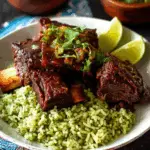Kimchi Fried Rice is a flavorful and spicy dish that takes your taste buds on a ride through the vibrant flavors of Korea. With the umami punch of gochujang and tangy, fermented kimchi, each bite offers a balance of heat, savory goodness, and satisfying texture. It’s the perfect way to use up leftover rice, transforming it into a delightful and fulfilling meal in minutes.
Top the fried rice with a runny fried egg, allowing the yolk to mix in with the grains for a rich, velvety touch. A sprinkle of sesame seeds and fresh green onions complete the dish, adding a nutty aroma and burst of color. This dish is perfect for a quick lunch, a cozy dinner, or whenever you’re craving a spicy, satisfying bowl of comfort food.
Full Recipe:
- 2 cups day-old cooked rice (short grain or medium grain)
- 1 tablespoon vegetable oil
- 1 cup kimchi, chopped
- 2 tablespoons kimchi juice
- 1 tablespoon gochujang (Korean chili paste)
- 2 teaspoons soy sauce
- 1 teaspoon sesame oil
- 2 green onions, chopped (white and green parts separated)
- 2 eggs
- 1 tablespoon butter (optional)
- Salt and pepper to taste
- Sesame seeds, for garnish
Directions:
- Heat vegetable oil in a large skillet or wok over medium-high heat.
- Add the white parts of the green onion and sauté until fragrant, about 1 minute.
- Add the chopped kimchi and cook for about 2-3 minutes until it starts to caramelize.
- Stir in the gochujang, soy sauce, and kimchi juice. Cook for another minute, allowing the flavors to blend.
- Add the rice to the skillet and mix well, breaking up any clumps. Stir-fry everything together for 5-7 minutes until the rice is heated through and slightly crispy on the edges.
- Push the rice to one side of the skillet and add butter (if using) to the empty side. Crack the eggs into the skillet and scramble until cooked to your preference, then mix them into the rice.
- Drizzle sesame oil over the rice, add the green parts of the green onion, and toss to combine. Season with salt and pepper to taste.
- Garnish with sesame seeds before serving.
Prep Time: 10 minutes | Cooking Time: 15 minutes | Total Time: 25 minutes
Kcal: 350 kcal | Servings: 2 servings
Origins & Cultural Significance
Kimchi Fried Rice, or “Kimchi Bokkeumbap” (김치볶음밥), is a staple in Korean households and is often enjoyed as a comfort food. It’s a dish born from the need to use up leftover ingredients, particularly rice and kimchi. This makes it not only delicious but also resourceful and eco-friendly. The fried rice is commonly topped with a fried egg, which adds richness and helps mellow out the spiciness of the kimchi and gochujang.
The Key Ingredients
- Kimchi: This fermented cabbage is the star of the dish, offering a tangy, spicy flavor that deepens as it’s cooked. Older, more fermented kimchi is often preferred for its intense flavor and slightly sour taste, which adds depth to the dish.
- Rice: Day-old rice works best for fried rice as it is drier, preventing the dish from becoming too sticky or mushy. Short or medium-grain rice is ideal as it has the right balance of starch to hold the flavors.
- Gochujang: The Korean chili paste is a flavor bomb, combining spice, sweetness, and umami in one. It’s a key ingredient that brings a unique depth to the fried rice.
- Eggs: A runny fried egg on top of the rice is almost non-negotiable in traditional kimchi fried rice. The egg yolk adds a creamy texture and a rich flavor that balances the spiciness and saltiness of the dish.
Flavor Profile & Customizations
Kimchi Fried Rice has a delightful balance of flavors: it’s savory, spicy, a little sour from the kimchi, and slightly sweet from the gochujang. The toasted rice bits from the frying process add a wonderful crunch to every bite. You can adjust the spice level to your preference—more gochujang for extra heat or less for a milder flavor.
Variations & Add-Ons
- Protein Boost: Add diced pork belly, spam, chicken, or tofu for a heartier dish. Bacon or ham are also popular protein choices.
- Vegetables: Feel free to throw in additional vegetables such as diced carrots, peas, mushrooms, or bell peppers for more texture and nutrition.
- Cheese Topping: A modern twist on Kimchi Fried Rice is to top it with a layer of cheese, which melts over the hot rice and creates a creamy, gooey topping.
Health Benefits
- Fermented Goodness: Kimchi is a probiotic-rich food, meaning it contains beneficial bacteria that support gut health and digestion.
- Nutrient-Rich: This dish is packed with vitamins (A, B, C), minerals (like iron and calcium), and antioxidants, thanks to the ingredients like kimchi, green onions, and optional veggies.
Serving Suggestions
Kimchi Fried Rice is versatile in how it can be served. Traditionally, it’s a one-bowl meal, but it can be paired with various Korean side dishes known as “banchan,” such as sautéed spinach, bean sprouts, or pickled radishes. A side of seaweed soup or miso soup also complements the meal perfectly.
Tips for the Best Kimchi Fried Rice
- Use Well-Fermented Kimchi: Older kimchi has a stronger flavor, which is ideal for cooking. It adds more depth and a punchier taste to the fried rice.
- Cook Over High Heat: To achieve that signature smoky flavor and crispy rice texture, stir-fry over medium-high heat, letting the rice toast slightly on the bottom.
- Balance the Seasoning: The combination of gochujang, soy sauce, and kimchi provides the primary seasoning, but taste as you go to adjust the saltiness or spiciness to your liking.
Dietary Modifications
- Vegetarian-Friendly: To make this dish vegetarian, use vegetable stock instead of fish sauce or soy sauce, and skip any meat-based add-ons.
- Gluten-Free: Make sure to use gluten-free soy sauce (tamari) and a gluten-free version of gochujang, as some traditional versions may contain wheat.
Fun Fact
Kimchi Fried Rice is so beloved in Korea that it’s often found in restaurants, homes, and even at barbecue joints, where it’s cooked on the grill after the meats are done, absorbing all the tasty juices left behind.
Kimchi Fried Rice in Korean Cuisine
Kimchi Bokkeumbap is a prime example of “Bokkeum,” which refers to stir-fried dishes in Korean cuisine. The “Bap” in the name means rice, making it clear that this is a stir-fried rice dish. It’s considered a humble, everyday meal, often made by combining leftovers to prevent waste—similar to other fried rice dishes in Asian cultures, such as Chinese Yangzhou fried rice or Japanese Chahan.
A Comfort Food with International Appeal
While Kimchi Fried Rice has its roots firmly planted in Korean culinary traditions, it has gained international popularity over the years. Its mix of complex flavors—savory, tangy, and spicy—makes it an appealing dish for food lovers around the globe. Whether you’re familiar with Korean food or trying it for the first time, the comforting simplicity and bold flavors of Kimchi Fried Rice make it an accessible introduction to Korean cuisine.
Health Aspects of the Dish
- Low in Calories but Filling: Each serving of Kimchi Fried Rice generally contains around 350 calories, making it relatively light but very filling due to the fiber and protein content from the rice, vegetables, and egg.
- Kimchi’s Probiotics and Nutrients: The probiotics found in kimchi, like lactic acid bacteria, aid digestion and boost immunity. Kimchi is also high in vitamins A, B, and C and antioxidants, which are essential for good health.
- Gochujang’s Benefits: This chili paste not only adds flavor but also contains capsaicin, which has been associated with metabolism-boosting properties and provides the dish with its characteristic heat.
Ways to Elevate Your Kimchi Fried Rice
- Seasoned Oil: Try using garlic-infused sesame oil or chili oil instead of plain vegetable oil to add another layer of flavor to your fried rice.
- Crispy Rice Finish: For an extra crunch, let the rice cook undisturbed in the pan for a few minutes before stirring, creating a delicious crust at the bottom, similar to a “bibimbap” (stone pot rice).
- Personalized Toppings: Beyond the classic fried egg, other topping ideas include seaweed strips (gim), toasted nori flakes, roasted peanuts, or even a drizzle of sriracha for more spice.
Cultural Variations Across Korea
Different regions in Korea might have their own spin on Kimchi Fried Rice. For instance:
- Seafood Kimchi Bokkeumbap: Coastal regions may add fresh seafood like shrimp, squid, or mussels for a “haemul” (seafood) version.
- Bulgogi Kimchi Fried Rice: A more luxurious version involves adding marinated beef bulgogi, giving the dish a sweet-savory flavor twist.
- Vegetable-Rich Kimchi Rice: Vegetarian households often include additional seasonal vegetables like zucchini, mushrooms, or bok choy, depending on availability and preference.
Serving Ideas & Plating Tips
- Bowl Presentation: Traditionally served in a wide bowl with the fried egg placed on top, so the yolk can be broken and mixed in.
- Cast Iron Sizzle: For a restaurant-style presentation, serve the fried rice on a cast-iron skillet to maintain heat, creating a sizzling effect as it’s brought to the table.
- Korean BBQ Pairing: Kimchi Fried Rice makes an excellent side dish for Korean BBQ. The spiciness and acidity of the kimchi help cut through the richness of grilled meats like samgyeopsal (pork belly) or galbi (marinated short ribs).
Tips for the Perfect Kimchi Fried Rice
- Balance the Acidity: If the kimchi is overly sour, balance the flavor with a bit of sugar or honey. This sweet touch rounds out the spiciness and tanginess.
- Choose the Right Rice: The best rice for Kimchi Fried Rice is leftover short or medium-grain rice that is slightly dry and separated. Freshly cooked rice can be too moist, making it stick together.
- Fry in Batches: If you’re making a large portion, fry the rice in batches. Overcrowding the pan can lead to steaming rather than frying, resulting in softer rice.
Interesting Facts & Stories
- A Popular Korean Side Dish: Kimchi Fried Rice is a popular side dish at Korean BBQ restaurants. After finishing the meats, it’s common for the waiter to use the remaining grilled bits on the hot plate to make fried rice, infusing it with the smoky, savory flavors left behind.
- Kimchi Evolution: The original form of kimchi dates back over 2,000 years, initially as a basic pickled cabbage. Over time, more spices and ingredients were added, and now there are over 200 varieties of kimchi in Korea, each with unique flavors based on the season, region, and preparation method.
- Part of Korean “Hangover Food” Culture: Just like ramen or broth-based soups, Kimchi Fried Rice is often enjoyed as a hangover cure in Korea. The combination of rice, spice, and savory toppings is believed to help replenish nutrients and rehydrate the body after a night of drinking.
Pairings & Beverages
Kimchi Fried Rice is often enjoyed with refreshing and light drinks to balance out the spiciness and savoriness of the dish:
- Korean Soju: A traditional rice-based spirit that pairs well with the spicy flavors of the kimchi.
- Iced Barley Tea (Bori-cha): A toasty and slightly nutty tea that is refreshing and soothing, making it a great palate cleanser.
- Makgeolli (Korean Rice Wine): A lightly sparkling and slightly sweet rice wine that complements the fried rice and adds a playful note to the meal.
A Modern Twist: Kimchi Fried Rice with Cheese
A popular modern take on Kimchi Fried Rice is to add a cheese topping, inspired by Western flavors and Korean street food trends. A layer of mozzarella cheese is often melted on top of the rice, creating a fusion dish that’s stretchy, gooey, and utterly delicious.
Conclusion
Kimchi Fried Rice is a quick, flavorful, and versatile dish that offers a taste of Korean comfort food at its best. With its perfect balance of spicy, savory, and tangy flavors, it’s easy to customize and ideal for using up leftover rice and ingredients. Whether enjoyed as a simple weeknight meal or dressed up with creative toppings, this dish is sure to become a go-to favorite for anyone craving a satisfying and delicious bowl of fried rice with a kick.






